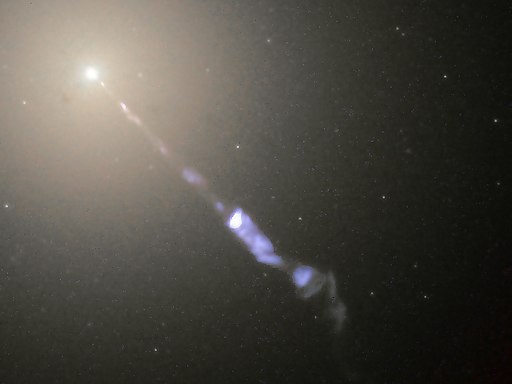In 1915, Albert Einstein predicted the existence of black holes in his general theory of relativity. It was not until 2019 that the Event Horizon Telescope (EHT) made history by releasing the first-ever image of a black hole.

Discovery of M87 Galaxy Black Hole
At the center of the Virgo cluster lies a supergiant elliptical galaxy that contains several trillion stars. This galaxy is named after its discoverer, Charles Messier, who in 1781 published an astronomical catalog of 110 nebulae and star clusters.
Messier 87 galaxy, or M87, is 54 million light-years away from Earth. It has an apparent magnitude of 9.6 and can be observed even with a small telescope, especially during May.
Over a century ago, astronomers observed a mysterious jet of hot plasma emanating from the center of the M87 galaxy. In the 1950s, radio astronomy revealed the presence of a compact bright radio source. Scientists suspected that a massive black hole at the center of the galaxy powers this activity.
The Event Horizon Telescope was launched in 2009 through international collaboration to capture images of a black hole. Starting in the 1970s, the planet-scale array of eight ground-based radio telescopes gathered data that could support the theory that M87 indeed harbored a black hole at its center.
In 2017, EHT obtained observations of M87 over several days from various radio telescopes, which were linked together simultaneously to generate the highest possible resolution. Finally, in 2019, the iconic "orange donut" image of the M87 black hole was released to the public, reflecting the first attempt to produce an image from such observations.
READ ALSO: AI Boosts Image of Supermassive Black Hole M87 to Full Resolution, Leading to Stunning Results
Cosmic Void Structure Revealed
In 2000, NASA's Hubble Space Telescope captured an image of the M87 galaxy where they discovered a jet of electrons and other subatomic particles streaming out from the center. In this photo, the blue part of the jet contrasts with the yellow glow coming from the combined light of billions of stars and the globular clusters that make up the galaxy.
Another team of researchers used a network of radio telescopes called the Global Millimeter VLBI Array to produce a new image of the M87 galaxy black hole. The new composite image includes the structure of the superheated material surrounding it, the high-speed jet, and the menacing shadow of the actual black hole.
To improve the resolution of the new image, the observational data from the northern Greenland Telescope and the southerly Atacama Millimeter/ submillimeter Array (ALMA) was added. The updated image shows a larger ring, which is 50% larger than previously thought, revealing more superheated plasma swirling around the void. This can be considered a glowing donut with a fluffy, reddish-orange ring. Additionally, streams of plasma traveling away from the ring appear to be a powerful jet of material that is heated up and accelerated out of the center of the galaxy.
RELATED ARTICLE: Spinning Black Hole Detected For the First Time: Astronomers Observed Cosmic Jets at the Center of M87 Galaxy
Check out more news and information on the M87 Galaxy in Science Times.














